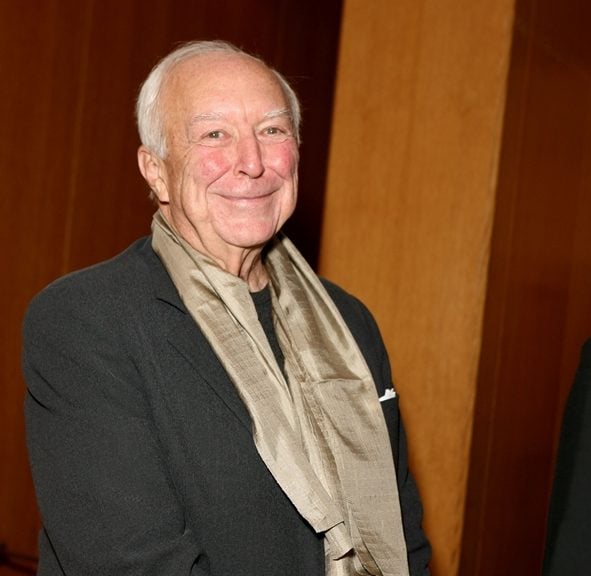
Midway through last week, visiting “Jasper Johns: Something Resembling Truth,” up at the Broad in downtown Los Angeles, meant waiting in line for at least 15 minutes, even for advance ticket holders. There might be bottlenecks of bodies outside the galleries or in front of wall labels, a rare experience in this city, especially for a show of understated postwar painting. Though the museum trumpeted its free admission when it opened in 2015, it still charges $25 per ticket for special exhibitions, including this one.
That didn’t appear to be too much of an impediment, however, despite the fact that Johns’s work is not as flashily photogenic as the artists who filled these galleries before him, namely Yayoi Kusama and Cindy Sherman.
Installation view of “Jasper Johns: Something Resembling Truth” at the Broad. Photo by Pablo Enriquez. Art © Jasper Johns/Licensed by VAGA, New York, NY.
The first painting in “Something Resembling Truth” hangs outside the entrance to the main galleries. A wall unto itself, Painting with Two Balls (1960), a great early work, features a bright pattern of messy, expressive paint patches methodically distributed across three stacked canvases, the top two divided by a pair of paint-spattered ball bearings. This was always a joke, a poke at the artist’s ab-ex predecessors, who seemed so proud of their own “ballsy-ness.” The writer Tom Wolfe probably had something like this work in mind when, in 1975, he described Johns as “zapping the old bastards.”
Johns himself still owns this painting, as he does many of the show’s other highlights. The fact that it hangs in this museum, founded by the billionaire entrpreneur Eli Broad, who owns an ungodly number of works by Jeff Koons, only goes to further establish Johns not so much as a virtuosic twentieth-century trickster but as a calculated master of his own legacy.
Jasper Johns’s Untitled (1975). The Eli and Edythe L. Broad Collection. Art © Jasper Johns / Licensed by VAGA, New York, NY. Photo: Douglas M. Parker Studio.
That the Broad’s exhibition, helmed by associate curator Ed Schad and director Joanne Heyler, managed to respect Johns’s savvy restraint while still feeling something like a candy store is a confounding, impressive feat. In this flashy, youth-friendly space, it could have come off as dryly elitist.
By some accounts “Something Resembling” was dryer at the Royal Academy of Art, which co-organized the show and included 30 more paintings in its larger, centuries-older galleries. “[I]t’s tricky to write about without sounding pretentious,” wrote critic Alastair Sooke in a largely positive Telegraph review of the show.
In installation shots, the paintings appear spotlit, with somber darkness marking the walls between. At the Broad, on the other hand, the walls are uniformly bright. Preparators washed them with light as evenly as possible and used cooler LEDs to make the rooms look brighter than they actually are.
Installation view of “Jasper Johns: Something Resembling Truth” at the Broad. Photo by Pablo Enriquez. Art © Jasper Johns/Licensed by VAGA, New York, NY.
This has an equalizing effect on Johns’s work. Since the show is organized thematically rather than chronologically, paintings from vastly different eras often share gallery space, jumping between his flag fixation to his sculptural experiments to his literature-inspired paintings. The consistent treatment leaves ample room for both fandom and forgiveness. Those nerdy, insider-y meditations on art history from the early 1990s—flattened Matisse spin-offs like Montez Singing (1989-90)—become less obscure when hanging across from the catenary paintings, obsessively subtle, monochrome meditations on curves that do what Johns does best: make complexity entirely accessible, yet no less profound for it.
The first gallery after Two Balls contains eight of Johns’s flag paintings. Some are literal, others slightly abstracted. The three literal flag depictions dating to 1958 are made with encaustic and collaged newspaper, an old-fashioned process that makes them dense and nostalgic despite their impudence. (The former Museum of Modern Art director Alfred Barr famously had architect Philip Johnson buy and donate one of Johns’s early flags so that Barr wouldn’t take heat for adding to the museum what might be considered a jab at patriotism.)
Across the room hangs Flag (1965), an optical illusion. Last week, I overheard a young visitor tell his companion to stare at the white dot in the center of the black, green, and orange flag then move her eye down to the black dot on another gray flag, over which an afterimage would hover. He spoke as if he’d divined the trick himself, though the wall label explained it.
Jasper Johns’s Three Flags (1958). Art © Jasper Johns / Licensed by VAGA, New York, NY.
Press releases arguing for this particular show’s necessity in London and LA cited a lack of important Johns exhibitions in recent years. London hasn’t hosted a museum survey of his work since 1978, while LA only gets the occasional print show since Matthew Marks opened in town. When the New York Times’s Deborah Solomon asked Johns why he was exhibiting at the Broad, he said he wanted to reach young people. (He also said that he liked that the museum was free; Solomon told him about the $25 special charge. “I don’t think I knew that,” replied Johns, apparently “perturbed.”)
The exhibition may indeed be particularly illuminating for younger Angelenos, who, even if they visit museums regularly would rarely see Johns paintings (LACMA and MOCA mostly own prints). It’s seductively installed, lit to make colors pop. The aspiring painter can, and should, geek out over Johns’s surface texture, trompe l’oeil, and material competence. But the Broad, with its ahistorical hanging, does to Johns what it usually does to art: privileges objects over context. Hopefully viewers will be beguiled enough to learn on their own how deftly Johns’s work spoke and responded to his political and aesthetic milieu.
“Jasper Johns: Something Resembling Truth” is on view at the Broad, 221 S Grand Ave, Los Angeles, February 10–May 13, 2018.